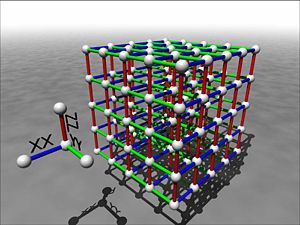Difference between revisions of "Research:Self Correcting Quantum Computers"
(New page: Our confidence that the quest to build a large scale robust quantum computer is not a wild goose chase arises from the theory of fault-tolerant quantum computation. This theory tells us t...) |
|||
| Line 3: | Line 3: | ||
[[Image:Grid.jpg|right|thumb|width=250px|A potential quantum memory]] | [[Image:Grid.jpg|right|thumb|width=250px|A potential quantum memory]] | ||
We are persuing one possible alternative towards the standard method for constructing fault-tolerant quantum computers. The basic idea is motivated by examining why classical computers are able to perform fault-tolerant quantum computation. In particular we are investigating physical systems which have custom designed Hamiltonians such that the energy eigenvectors of these Hamiltonians are quantum error correcting codes and such that there is a free energy barrier preventing errors from occuring on this information. Such systems would "self-correct" in much the same way that spin domains on classical hard drives self-correct errors when kept below a critical tempature. | We are persuing one possible alternative towards the standard method for constructing fault-tolerant quantum computers. The basic idea is motivated by examining why classical computers are able to perform fault-tolerant quantum computation. In particular we are investigating physical systems which have custom designed Hamiltonians such that the energy eigenvectors of these Hamiltonians are quantum error correcting codes and such that there is a free energy barrier preventing errors from occuring on this information. Such systems would "self-correct" in much the same way that spin domains on classical hard drives self-correct errors when kept below a critical tempature. | ||
| + | |||
| + | '''References''' | ||
| + | |||
| + | * [[User:Dabacon|D. Bacon]], '''Operator Quantum Error-correcting Subsystems for Self-correcting Quantum Memories.''' Physical Review A, 73, 012340 (2006) | ||
| + | **[http://arxiv.org/abs/quant-ph/0506023 arXiv:quant-ph/0506023] [http://dx.doi.org/10.1103/PhysRevA.73.012340 published version] | ||
| + | * [[User:Dabacon|D. Bacon]], K.R. Brown, and K.B. Whaley, '''Coherence-Preserving Quantum Bits.''' Physical Review Letters, 87, 247902-1-247902-4 (2001) | ||
| + | **[http://arxiv.org/abs/quant-ph/0012018 arXiv:quant-ph/0012018] [http://dx.doi.org/10.1103/PhysRevLett.87.247902 published version] | ||
Revision as of 00:29, 9 February 2008
Our confidence that the quest to build a large scale robust quantum computer is not a wild goose chase arises from the theory of fault-tolerant quantum computation. This theory tells us that if noise on a quantum system is weak enough, and our control over the quantum system is precise enough, then robust large scale quantum computation is possible with only a small (polylogarithmic) blow up in the size of the quantum circuits needed to achieve this robustness. In spite of this theory, however, there are considerable difficulties to the construction of physical systems which enact fault-tolerant quantum computation. In particular the device complexity of most fault-tolerant quantum error correcting routines is quite severe. Is there a better way to build a robust quantum computer than by using the complex and costly currently known fault-tolerant constructions?
We are persuing one possible alternative towards the standard method for constructing fault-tolerant quantum computers. The basic idea is motivated by examining why classical computers are able to perform fault-tolerant quantum computation. In particular we are investigating physical systems which have custom designed Hamiltonians such that the energy eigenvectors of these Hamiltonians are quantum error correcting codes and such that there is a free energy barrier preventing errors from occuring on this information. Such systems would "self-correct" in much the same way that spin domains on classical hard drives self-correct errors when kept below a critical tempature.
References
